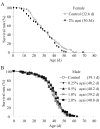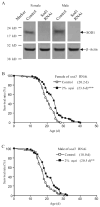Açai palm fruit (Euterpe oleracea Mart.) pulp improves survival of flies on a high fat diet
- PMID: 20080168
- PMCID: PMC2826513
- DOI: 10.1016/j.exger.2010.01.008
Açai palm fruit (Euterpe oleracea Mart.) pulp improves survival of flies on a high fat diet
Abstract
Reducing oxidative damage is thought to be an effective aging intervention. Açai, a fruit indigenous to the Amazon, is rich in phytochemicals that possesses high anti-oxidant activities, and has anti-inflammatory, anti-cancer and anti-cardiovascular disease properties. However, little is known about its potential anti-aging properties especially at the organismal level. Here we evaluated the effect of açai pulp on modulating lifespan in Drosophila melanogaster. We found that açai supplementation at 2% in the food increased the lifespan of female flies fed a high fat diet compared to the non-supplemented control. We measured transcript changes induced by açai for age-related genes. Although transcript levels of most genes tested were not altered, açai increased the transcript level of l(2)efl, a small heat-shock-related protein, and two detoxification genes, GstD1 and MtnA, while decreasing the transcript level of phosphoenolpyruvate carboxykinase (Pepck), a key gene involved in gluconeogenesis. Furthermore, açai increased the lifespan of oxidative stressed females caused by sod1 RNAi. This suggests that açai improves survival of flies fed a high fat diet through activation of stress response pathways and suppression of Pepck expression. Açai has the potential to antagonize the detrimental effect of fat in the diet and alleviate oxidative stress in aging.
Published by Elsevier Inc.
Figures




Similar articles
-
The interplay among dietary fat, sugar, protein and açai (Euterpe oleracea Mart.) pulp in modulating lifespan and reproduction in a Tephritid fruit fly.Exp Gerontol. 2012 Jul;47(7):536-9. doi: 10.1016/j.exger.2012.05.001. Epub 2012 May 11. Exp Gerontol. 2012. PMID: 22580089 Free PMC article.
-
A botanical containing freeze dried açai pulp promotes healthy aging and reduces oxidative damage in sod1 knockdown flies.Age (Dordr). 2013 Aug;35(4):1117-32. doi: 10.1007/s11357-012-9437-3. Epub 2012 May 26. Age (Dordr). 2013. PMID: 22639178 Free PMC article.
-
Açaí (Euterpe oleracea Mart.) in Health and Disease: A Critical Review.Nutrients. 2023 Feb 16;15(4):989. doi: 10.3390/nu15040989. Nutrients. 2023. PMID: 36839349 Free PMC article. Review.
-
Açai (Euterpe oleracea Mart.) Upregulates Paraoxonase 1 Gene Expression and Activity with Concomitant Reduction of Hepatic Steatosis in High-Fat Diet-Fed Rats.Oxid Med Cell Longev. 2016;2016:8379105. doi: 10.1155/2016/8379105. Epub 2016 Aug 25. Oxid Med Cell Longev. 2016. PMID: 27642496 Free PMC article.
-
The value of the Brazilian açai fruit as a therapeutic nutritional strategy for chronic kidney disease patients.Int Urol Nephrol. 2018 Dec;50(12):2207-2220. doi: 10.1007/s11255-018-1912-z. Epub 2018 Jun 18. Int Urol Nephrol. 2018. PMID: 29915880 Review.
Cited by
-
The Yang-Tonifying Herbal Medicine Cynomorium songaricum Extends Lifespan and Delays Aging in Drosophila.Evid Based Complement Alternat Med. 2012;2012:735481. doi: 10.1155/2012/735481. Epub 2012 Jul 15. Evid Based Complement Alternat Med. 2012. PMID: 22844336 Free PMC article.
-
The longevity effect of cranberry extract in Caenorhabditis elegans is modulated by daf-16 and osr-1.Age (Dordr). 2013 Oct;35(5):1559-74. doi: 10.1007/s11357-012-9459-x. Epub 2012 Aug 4. Age (Dordr). 2013. PMID: 22864793 Free PMC article.
-
Aging studies in Drosophila melanogaster.Methods Mol Biol. 2013;1048:77-93. doi: 10.1007/978-1-62703-556-9_7. Methods Mol Biol. 2013. PMID: 23929099 Free PMC article.
-
Nectarine promotes longevity in Drosophila melanogaster.Free Radic Biol Med. 2011 Jun 1;50(11):1669-78. doi: 10.1016/j.freeradbiomed.2011.03.011. Epub 2011 Mar 13. Free Radic Biol Med. 2011. PMID: 21406223 Free PMC article.
-
The interplay among dietary fat, sugar, protein and açai (Euterpe oleracea Mart.) pulp in modulating lifespan and reproduction in a Tephritid fruit fly.Exp Gerontol. 2012 Jul;47(7):536-9. doi: 10.1016/j.exger.2012.05.001. Epub 2012 May 11. Exp Gerontol. 2012. PMID: 22580089 Free PMC article.
References
-
- Bao Y, Fenwick R. Phytochemicals in health and disease. Marcel Dekker; New York: 2004.
-
- Pan MH, Lai CS, Dushenkov S, Ho CT. Modulation of inflammatory genes by natural dietary bioactive compounds. J Agric Food Chem. 2009;57:4467–77. - PubMed
-
- Joseph JA, Shukitt-Hale B, Lau FC. Fruit polyphenols and their effects on neuronal signaling and behavior in senescence. Ann N Y Acad Sci. 2007;1100:470–85. - PubMed
-
- Surh YJ. Dietary modulation of cell signaling pathways. CRC Press; Boca Raton: 2009.
Publication types
MeSH terms
Substances
Grants and funding
LinkOut - more resources
Full Text Sources
Other Literature Sources
Medical
Molecular Biology Databases
Miscellaneous

